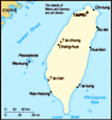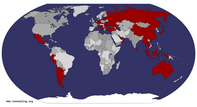Advertisement
Published: March 16th 2013

 Sands of Time
Sands of Time
Xiaonan City God TempleTime's running out, commitments are drawing near, so we skip a few destinations in the southern and central regions, and head straight to Tainan. The city was recommended to me by a friend whose judgment can generally be trusted. Tainan is the oldest city in the country, and its fourth largest. Hence, we find a dynamic city steeped in history and traditional culture, just what we're looking for.
It's the second day of Chinese New Year, which means that unfortunately, we have to pay a little too much for our faceless, danky hotel room. Also, we find things a tad unpredictable, especially opening hours of restaurants and museums. On our first night, we walk around, trying to get a late-night snack, but can't find anything worth mentioning. No local food stalls, nothing. So we settle for 7-11. Rather depressing, but what do you when you don't have a choice? Taking the underpass underneath the train station, we find a long row of homeless people sitting, eating, drinking and sleeping on their cardboard boxes. They are arranged almost like homes, with cardboard walls and little gaps in between two cardboard homes for a semblance of privacy. This is the first time
we are confronted by stark poverty in Taiwan. Most of the homeless are elderly, some of them are drunk and shouting or arguing, others are eating two-minute noodles, while yet others just sit there, staring into nothingness.
***
In the morning, we pass by a shopping mall where a group of kids dressed up Chinese opera-style, complete with impressive and intricate mask facepaint, are busy rehearsing for a show or a play. They are all very serious and stay in character the whole time, without once smiling or laughing or talking unnecessarily. It's fascinating to see how highly valued this artform is here, and how respectfully it is approached even by little children. They go through their choreography several times, lining up afterwards to get criticised by the director.
Tainan is a city of temples, and we are determined to visit as many of them as possible. The first one we set foot into is the God of War Temple aka Sacrificial Rites Martial Temple. It dates to 1665, which makes it one of the oldest temples in Taiwan. We marvel at the wall artwork and observe the faithful burning ghost money for

 Figurines
Figurines
Taoist temple in Anpingtheir deceased relatives. Just a tiny alley away is the Grand Matsu Temple, one of around 1500 temples in Taiwan dedicated to Matsu, the Empress of Heaven and Taiwan's patron deity. To be honest, the myriad of gods and minor deities make a visit to a temple in this country rather confusing. Who are they and what do they do? Why do people pray to them? We don't even know whether a temple is Buddhist or Taoist, and we're not sure if it matters. There must be subtle and obvious differences, but where to find them?
Fortunately, the transition between sacred and profane is a smooth one in Taiwan, so you're free to take pictures and walk pretty much anywhere inside the temples without having to worry about offending anybody. You can wear a hat or no hat, sunnies if you want to, you can drink, chew gum and stare at a nun. However, when at the Grand Matsu Temple, we see people walking through a tunnel, lining up after exiting to be blessed (I guess) by a type of priest, and decide on a whim to do it as well, the priest gives us a weird look and

 White suggests sinisterness, treacherousness, suspiciousness and craftiness
White suggests sinisterness, treacherousness, suspiciousness and craftiness
Commonly seen on the stage is the white face for the powerful villain; it highlights all that is bad in human nature: cunning, craftiness, and treacheryspeaks to us in a rather unfriendly manner. When we're not able to produce a reply in Mandarin, he gets impatient and we decide it's better to just move on and forget about the whole charade.
We head to the famous Chihkan Tower, a fort that was built in 1653 by the Dutch. Formerly known as Fort Provintia, the Tower was surrendered in 1662 to the Chinese military leader Koxinga. The latter is still revered and worshipped in Taiwan for expelling the Dutch, and even has a temple dedicated to him in Tainan. The fort is teeming with people on this sunny day, but we still manage a pleasant visit at a leisurely pace.
Later that day we drop by beautiful Tiangong Temple, City God Temple, which sports a large abacus above the main entrance, as well as Dongyue Temple, where the walls are adored with gruesome murals depicting disembowelments, stabbings and all kinds of other sick torture. All that graphic brutality has made us rather hungry. Lucky there's an adjacent vegetarian eatery with a fantastic buffet featuring many kinds of baozi and pan-fried buns. What better way to end a full-on day of sights and temples.

 Red and green masks
Red and green masks
A green face tells the audience that the character is impulsive and violent and depicts surly stubbornness, impetuosity and a total lack of self-restraint.***
The following day we dedicate fully to Anping, a seaside district of Tainan. The bus there takes about 45 minutes from central Tainan. We walk right into the old part of town, where some of Taiwan's oldest streets are located. They are interconnected via a number of back alleys, and once we start exloring those, things become a little confusing. Still, anywhere we go, we find food. And we are quite receptive on this day, I'd say. We eat baozi, chao doufu, barbecued chao doufu, then we drink a juice here, a tea there. Oh, little cheesecakes! And guava juice! And guava! There's some crispy seaweed! And beetroot chips! Are those rice crackers? It's so hot, better buy another lime juice. And orange tea. Oooh, ice cream! Ooooooh, ice cream in a crepe with nuts and parsley! Wait, parsley? Doesn't matter! I'm kind of full...is that flan? It is! Chomp, chomp, chomp...
Don't judge us, we are just doing a very Taiwanese thing. Taiwanese people are pretty crazy about food. And about horribly posing for hundreds of pictures. Especially inside of old buildings, of which there are many in Anping. There's the former
house of Julius Mannich, a German merchant. Of course, they need a restaurant in there selling pork knuckles, sausages, pork belly and other swinish German food. There's an old dormitory built for Japanese salt company officials during the Ming Dynasty. Last but not least, there's Fort Zeelandia, a former Dutch fort, if you couldn't already guess it from the name. Like Chihkan Tower, it was captured by Koxinga in 1661. The grounds are more vast and impressive, though, and we really take our time absorbing everything.
We also visit a few temples, including the splendid Anping Matsu Temple, which is claimed to be the oldest in Taiwan. However, it is in a smaller Taoist temple in a backalley that we experience something rather special: in front of the temple, a band starts playing some intense, percussion-heavy music. There are a few bystanders in pink polo-shirts, and all of a sudden, one of them starts dancing wildly, shaking his arms and jumping on one leg. This goes on for maybe half a minute, when the other polo-shirt-men usher him inside the temple, where they help him get changed (shielded by two rugs they hold around him) into a purple robe
with a large yin-yang on the chest area. He appears to be in trance, fluttering his eyelids and making sounds reminiscent of Dr. Zoidberg, which is probably supposed to be speaking in tongues. He goes up to the main altar, strikes a pose, mumbles to himself, then gets approached by a man, who confides some information to him. He listens intently, intermittently uttering kookaburra-like sounds, proceeds to light a few joss sticks, pray to the gods, mumble some more and tell the man the result of his conference with some higher power. It seems he's acting as a type of medium between this world and the afterworld.
When he walks back to the altar, he passes me, as I'm wedged in the corner, trying to get good shots. When he sees me, I can see him break character for a split second. A foreigner was probably the last thing he expected. He nods at me, becoming a mere mortal for this brief instant, then continues to utter his staccato-syllables. Back at the altar, he sits down and allows a few more consultations by anxious believers. A massive golden dragon seal stamp comes into the equation, but what exactly it
does, I'm not sure. The wizard reads a large paper, then places the seal on an ink pad and deliberately and theatrically stamps the paper. Afterwards, he adds a few characters with a paint brush. The whole show is dramatic, exaggerated and highly intense. The fervent faithfuls who are lucky enough to have been chosen to ask a question afterwards get down on their knees to be touched on the forehead by the wizard. One has her bracelet blessed by him. It's all very cryptic to the uninitiated, and there appears to be quite a bit of money involved, although the payments are made discreetly.
***
With this unanticipated episode, our day in Anping, as well as our little trip around the island, comes to an end. We take the HSR train (High Speed Rail) back to Taipei, where the next chapter begins.
Advertisement
Tot: 0.254s; Tpl: 0.013s; cc: 42; qc: 134; dbt: 0.1765s; 1; m:domysql w:travelblog (10.17.0.13); sld: 1;
; mem: 1.6mb



























